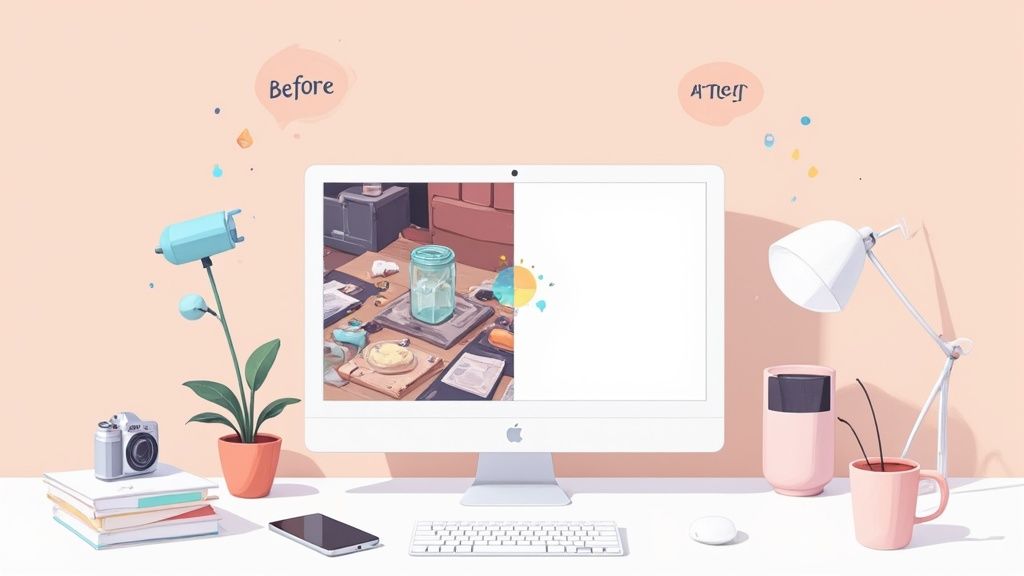Let’s be honest: your product photos are your best salespeople. They’re the first handshake, the product demo, and the quality guarantee all rolled into one. In the world of e-commerce, where customers can’t physically touch or hold your products, a killer image is your most powerful tool for building trust and nudging them toward that "add to cart" button.
This is where e-commerce photo editing comes into play. It’s the process of taking a good product photo and making it great. We’re talking about techniques like background removal, color correction, and retouching to create those crisp, professional, high-quality visuals you see on major retail sites. This isn't just about making pictures look pretty; it's a fundamental strategy for any online store.
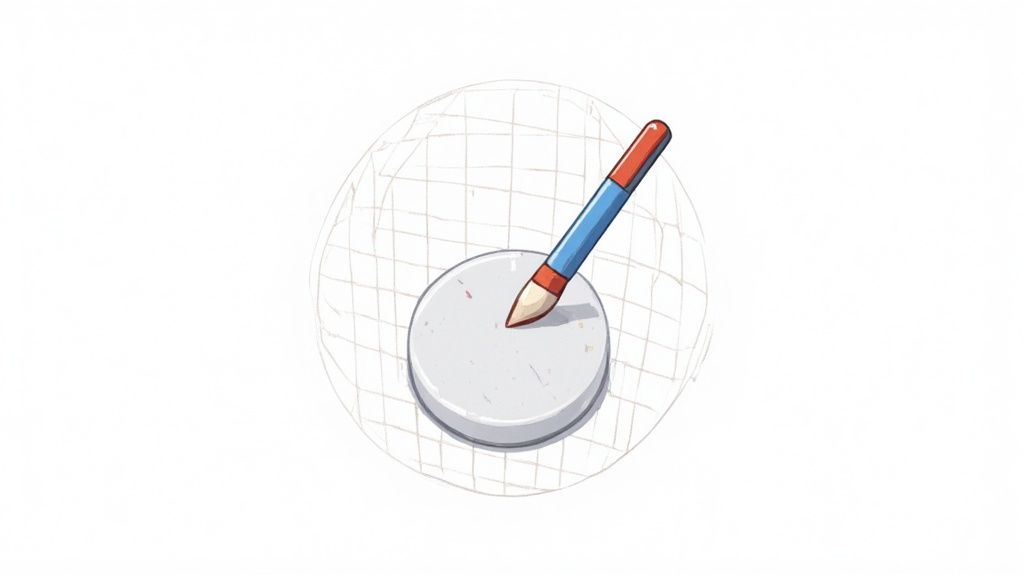
A raw, unedited photo might show the product, but a professionally edited one tells a story. It instantly communicates quality, attention to detail, and brand credibility. The psychological impact here is huge. Shoppers instinctively judge a product’s value based on how it's presented. A sharp, clean image suggests a premium item, while a poorly lit, cluttered photo can make even a high-end product feel cheap.
Build Trust Through Visual Consistency
Think about your favorite online stores. Chances are, their product listings have a clean, uniform look. This isn't an accident. When every image has the same consistent lighting and professional finish, it creates a cohesive and trustworthy shopping experience. It makes your brand look established and reliable.
Here’s what that consistency and quality get you:
- Higher Conversion Rates: It's simple. Polished, professional images lead directly to more sales.
- Fewer Product Returns: When colors and details are accurate, customers know exactly what they’re getting. No surprises, no disappointments.
- A Stronger Brand: A professional look elevates your entire brand identity, making you look more credible than the competition.
The Ever-Growing Importance of Quality Images
The proof is in the numbers. The e-commerce product photography market is on a rocket ship, projected to grow from around USD 1 billion to approximately USD 2 billion by 2033. This boom isn’t happening in a vacuum; it’s a direct response to how critical detailed, accurate, and appealing photos have become in our purchasing decisions.
Ultimately, investing in photo editing is an investment in your customer's confidence. Understanding just how much a great photo matters is a key part of mastering digital marketing and driving real growth. It sets the stage for everything else you do, turning casual browsers into loyal customers by making a killer first impression.
Core Techniques for Professional Product Images
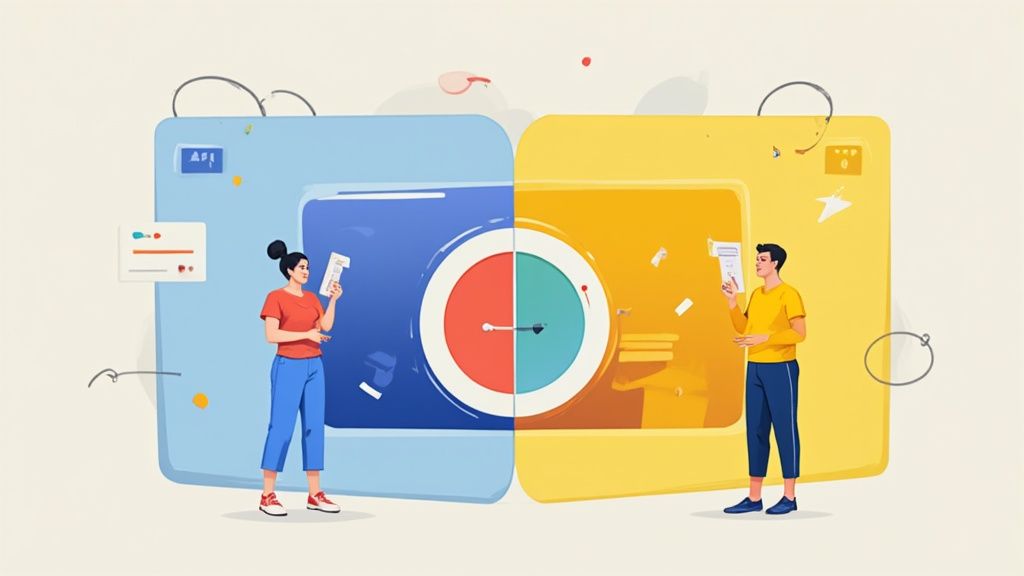
Fantastic product photos aren't just taken; they're made. The real magic happens after the shutter clicks, transforming a raw camera file into an image that actually drives sales. Think of e commerce photo editing as the final, crucial step that turns a good shot into a professional asset that builds shopper confidence and moves inventory.
These core skills work together to craft a clean, accurate, and appealing visual. Getting them right is fundamental to building a trustworthy online store that looks and feels consistent.
Creating a Clean Canvas with Background Removal
First up, and arguably the most common edit, is background removal.
Picture this: you're shopping for new sneakers, but every shoe is photographed on a different cluttered floor. It would feel amateurish and distracting, right? By stripping away the original background and placing the product on a clean, solid color—usually crisp white or a light grey—you create a sharp, consistent, catalog-style look.
This technique, sometimes called creating a "clipping path," isolates the product and makes it the undisputed hero of the image. The result is a focused visual that cuts out the noise, helping customers compare products easily across your entire store.
Ensuring True-to-Life Color Correction
Have you ever bought a shirt online that looked like a vibrant cherry red, only to open the package and find a dull maroon? That’s what happens when color correction is skipped. This process is all about tweaking the hues, saturation, and brightness to make sure the product on the screen is a dead ringer for the one that shows up at your customer's door.
Getting colors right isn't just about aesthetics; it’s about managing expectations and, frankly, cutting down on costly returns. For businesses in fashion, home goods, or cosmetics, accurate color can be the single most important factor in a buying decision.
A study even found that 85% of shoppers say color is the main reason they buy a product. If your colors are off, you aren't just misrepresenting your item—you're actively losing sales.
Refining Details with Retouching
Let's be real: no product is flawless, and no photoshoot is perfect. Tiny specks of dust, a small scratch from handling, or a stray fingerprint can easily show up in high-resolution photos. Retouching is the delicate art of cleaning up these minor imperfections to present the product in its absolute best light.
This isn't about changing the product itself. It’s about tidying up the image to get rid of small distractions. A professional editor might smooth out a few wrinkles on a dress shirt or remove a weird reflection from a piece of jewelry, making sure the customer’s focus stays on the quality of the item. For anyone looking to do this at scale, exploring different photo editing services for ecommerce can deliver professional quality without all the manual work.
Adding Realism with Shadow Creation
A product just floating on a white background can look flat, fake, and completely unrealistic. Adding a subtle drop shadow or a natural shadow is what grounds the object, giving it depth, dimension, and a sense of place.
Suddenly, the item feels tangible and three-dimensional, like it's sitting right there in front of the shopper. It's a final touch that adds a layer of professionalism that separates amateur snapshots from high-quality e-commerce photos that convert.
To tie it all together, here’s a quick look at how these fundamental techniques directly impact your bottom line.
Essential Editing Techniques and Their Business Impact
| Editing Technique | Problem It Solves | Impact on Sales |
|---|---|---|
| Background Removal | Distracting or inconsistent backgrounds | Creates a professional, clean look that improves brand perception and makes products easier to compare. |
| Color Correction | Inaccurate product colors on-screen | Builds trust by showing the product as it truly is, which drastically reduces returns due to "not as described" complaints. |
| Retouching | Minor flaws like dust, scratches, or smudges | Presents the product in its ideal state, highlighting quality and craftsmanship without being misleading. |
| Shadow Creation | Flat, "floating" product images | Makes products look more realistic and tangible, adding a professional polish that increases perceived value. |
Mastering these four pillars doesn't just make your photos look better—it directly addresses customer pain points, builds trust, and ultimately drives more sales.
How AI Is Changing the Photo Editing Game
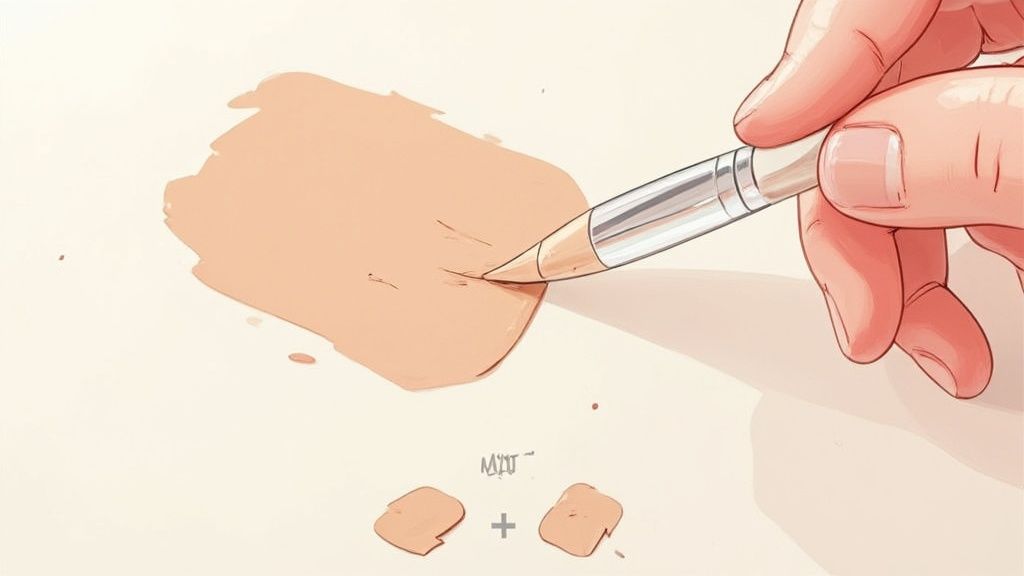
For a long time, manual photo editing has been a major bottleneck for online sellers. It gets the job done, but the process is slow, incredibly repetitive, and demands skills that are often expensive to hire for. Think of AI not as some complex, sci-fi concept, but as the ultimate workflow assistant—a tireless team member that handles all the heavy lifting in post-production.
That’s the new reality for e-commerce photo editing. AI-powered platforms are built to automate the most grinding, time-sucking tasks with stunning speed and consistency. They essentially act as your personal editing crew, freeing you up to focus on what really matters: marketing, talking to customers, and actually growing your business.
Hitting Warp Speed and Scaling Up
The real magic of AI is its ability to make thousands of tiny decisions in the blink of an eye. Imagine you need to remove the background from a hundred product photos. A human editor could spend hours, maybe even days, meticulously tracing every single product. An AI tool? It can knock out the entire batch in minutes, delivering clean, perfect results every time.
This isn't just about saving a bit of time here and there; it's about completely rethinking how you scale your store. With AI on your side, you can:
- Get new products live faster: Slash the time it takes to get from photoshoot to your product page.
- Keep your brand looking sharp: Apply the exact same edits and styles across thousands of images without a second thought.
- Lower your operating costs: Cut back on pricey software subscriptions or the need to outsource every little edit.
Beyond Simple Fixes to Creative Generation
But modern AI editing tools do so much more than just basic touch-ups. They're quickly becoming creative partners, able to generate incredible visuals that used to require a full-blown studio shoot.
Take a platform like ProdShot, for example. You can snap a simple photo of your product on your kitchen table, and it can instantly place it into a professionally designed lifestyle scene. The AI is smart enough to analyze the product and generate a brand new, realistic background, complete with the right lighting and shadows. This means you can create an endless stream of marketing images without ever booking a location or hiring models.
The real power of AI is that it makes professional results accessible to everyone. It gives small businesses and solo entrepreneurs the ability to create visuals that can go head-to-head with the big brands, leveling the playing field in a market that's all about visuals.
The growth in this space is impossible to ignore. The global photo editing app market, which is increasingly driven by AI, is expected to jump from USD 303.92 million to USD 402.37 million by 2032. These tools are becoming must-haves for anyone selling online, giving them the power to create sales-driving imagery with hardly any effort. You can dig deeper into these market trends and what they mean for e-commerce visual strategies.
Building Your Efficient Editing Workflow
Great product photos don't just happen by accident; they're the direct result of a smart, repeatable process. An efficient e commerce photo editing workflow is basically an assembly line for your visuals. It locks in consistency, saves you a ton of time, and makes sure every single image hits your brand’s quality standards before it ever goes live. If you don't have a solid process, you’re just asking for inconsistent results and wasted hours.
Think of it like a recipe. You wouldn't try to bake a cake by guessing the ingredients and mixing them randomly each time, right? A defined workflow does the same for your photos—it ensures every image gets the right treatment, in the right order, every single time. That predictability is the real secret to scaling up your visual content without letting quality slip.
To really get this right, it helps to understand the basics of automation. Digging into What Is Workflow Automation is a great first step, as it gives you the foundation for building systems that cut down on errors and give you back your time.
The Blueprint for a Repeatable Process
Building a solid workflow starts with mapping out every single stage of the editing journey. The specific tools you use might vary, but the core steps almost always stay the same. This structured approach takes the guesswork out of the equation and keeps your post-production on track, whether you're editing ten photos or ten thousand.
A typical workflow breaks down into these key phases:
- Culling and Organizing: The first cut is the deepest. Go through all your raw photos and get rid of anything that's blurry, poorly lit, or a duplicate. Only keep the best of the best. Then, organize those keepers into clearly labeled folders so you don't lose your mind later.
- Batch Editing: This is where you apply basic, consistent adjustments to all your selected images at once. Think foundational edits like exposure, white balance, and lens correction. Using presets here is a game-changer for creating a uniform look across your entire catalog.
- Individual Retouching: Now it's time to zoom in and handle the details. This is where you'll tackle specific tasks like background removal, cleaning up blemishes, and making precise color corrections to make each product pop.
- Final Quality Check: Before you hit "export," do one last sweep. Check for consistency in cropping, alignment, and color across all the images. This final look is your chance to catch any small mistakes that might have slipped through.
This handy visual breaks down what a simplified version of this process looks like, showing the core stages from start to finish.
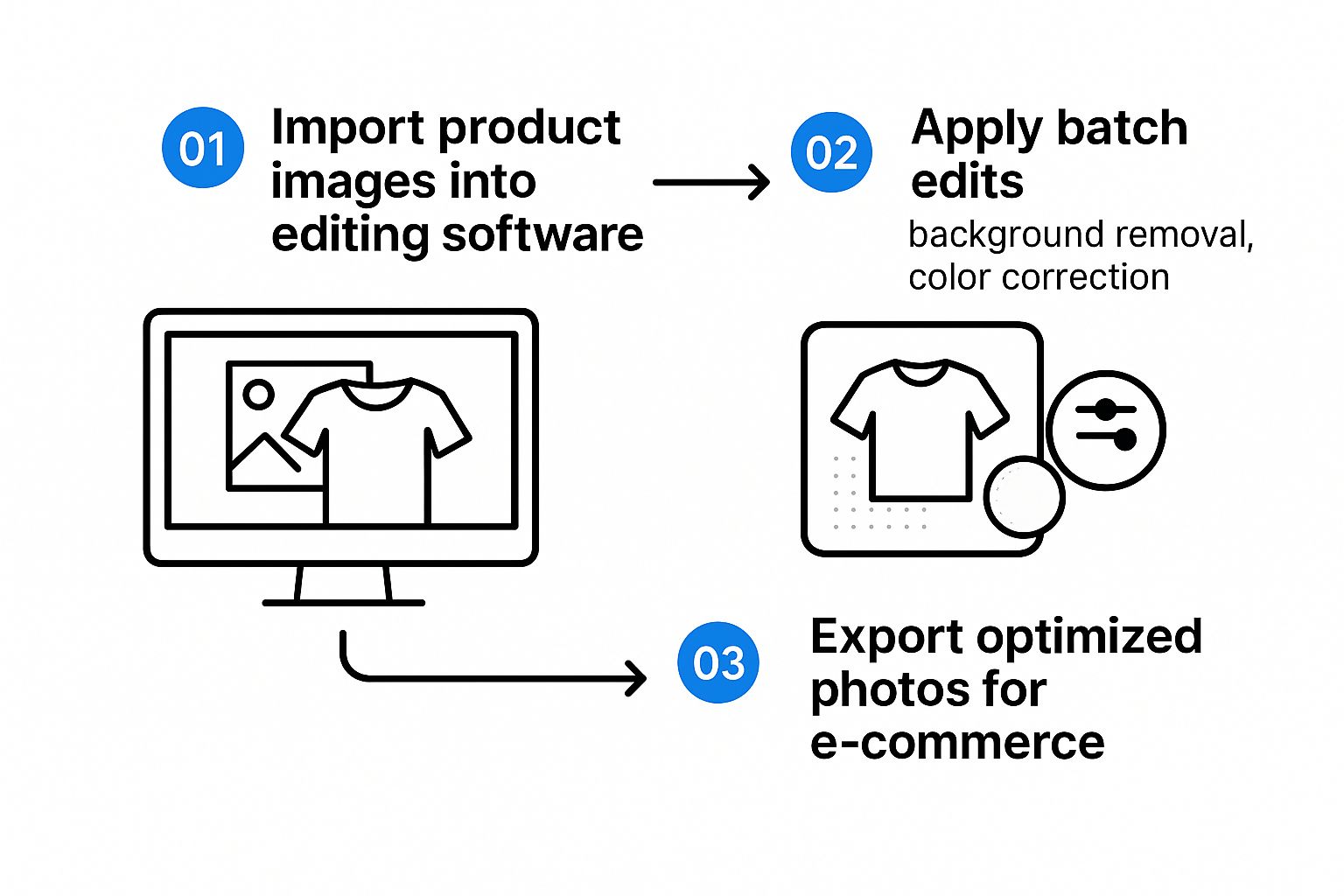
As you can see, a powerful workflow isn't complicated. It combines a bit of initial setup, batch processing to handle the heavy lifting, and a final optimization step to get your images ready for the web.
Choosing Your Workflow Model
Not every business has the same budget or team size, which is why your workflow needs to fit your specific situation. There are really three main ways to tackle this, and each one comes with its own pros and cons.
Finding the right approach isn't about buying the most expensive software or hiring a huge team. It's about picking the most sustainable and scalable process for where your business is right now, whether that means rolling up your sleeves yourself or leaning on powerful automation tools.
Comparing E Commerce Photo Editing Workflows
To figure out which path is best for you, let's compare the most common options side-by-side. This table breaks down the different models based on what they'll cost you in time and money, and what kind of expertise they demand.
| Workflow Model | Best For | Pros | Cons |
|---|---|---|---|
| DIY (Do It Yourself) | Startups, solo sellers with low volume, or those with existing editing skills. | Full creative control; lowest initial cost. | Extremely time-consuming; requires software expertise (e.g., Photoshop). |
| Hiring a Freelancer | Growing businesses that need high-quality results but aren't ready for a full-time hire. | Frees up your time; professional-quality results. | Can be expensive; requires finding and managing a reliable editor. |
| Using an AI Service | High-volume sellers, marketplaces, and brands needing speed and consistency. | Incredibly fast and scalable; delivers consistent, professional images 24/7. | Less manual creative control over the final details. |
Ultimately, the choice comes down to a trade-off between time, money, and control.
For instance, the DIY approach gives you total control and is cheap upfront, but it's a massive time sink and requires you to know your way around software like Photoshop. It’s perfect if you're just starting out with a handful of products.
Hiring a freelancer is a great middle-ground. You get professional results and your time back, but it costs more and you have to find someone you trust. This works well for businesses that are starting to scale.
Then there's the AI route. Platforms like ProdShot automate almost the entire process. This is, by far, the fastest and most scalable option out there, cranking out consistent, professional images in minutes. It's the ideal solution for anyone dealing with a high volume of products who can't afford to sacrifice quality for speed.
Let's be honest, a gorgeous product photo is completely worthless if it takes forever to load. In the world of e-commerce, site speed isn't just a geeky tech metric—it's a massive part of the customer experience. A slow page will frustrate a potential buyer and send them clicking over to your competitor before they even get a chance to see what you're selling.
This is where the technical side of e commerce photo editing becomes mission-critical. It's a balancing act: you need stunning visual quality, but you also need a tiny file size. Think of it like packing a suitcase for a trip. You want to bring all your favorite outfits, but you can't make the bag so heavy you can't lift it. Getting this right creates a fast, smooth shopping experience that keeps both customers and search engines happy.
Choosing the Right File Format
The first step in getting your images in shape is picking the right file format for the job. Each one has its own strengths, and just choosing the correct one can make a huge difference in how quickly your pages load.
Here’s a quick rundown of the big three:
- JPEG (or JPG): This is the workhorse format for most product photos. JPEGs are fantastic at compressing images with lots of colors and details—like a photo of a patterned dress or a lifestyle shot—into a much smaller file.
- PNG: This is your go-to whenever you need a transparent background. If you've just removed the background from your product and want to place it on different colored sections of your site, PNG is the perfect choice. It keeps those edges clean and crisp.
- WebP: A much newer format from Google, WebP is the best of both worlds. It offers incredible compression while keeping the image quality high, often creating files that are smaller than both JPEGs and PNGs. It’s a great modern option for anyone serious about site speed.
Making Your Images Discoverable with SEO
Okay, so your images are fast. Now what? You need to make sure search engines can actually understand what they're looking at. When you get this right, your products can start showing up in Google Images, driving a ton of free, organic traffic straight to your store. This goes beyond the visual edit; you have to pay attention to the data attached to the image. For a deeper dive, it helps to understand the basics of on-page SEO techniques.
Your two most powerful tools here are file names and alt text.
Seriously, stop using generic camera names like IMG_8432.jpg. Instead, rename the file to something that actually describes the product, like blue-wool-turtleneck-sweater.jpg.
Alt text, or alternative text, is a simple description of the image for people who can't see it. But it’s also a massive clue for search engines. A great alt text for that sweater would be: "Model wearing a blue wool turtleneck sweater against a white background."
This simple housekeeping makes your images accessible and gives Google the context it needs to rank your products. And for store owners on specific platforms, using a dedicated Shopify photo editor can often help automate some of these optimization steps, making sure every image is ready to perform from the get-go.
Investing in killer product photos feels like the right move, but how do you actually prove it's making you money? The trick is to stop thinking of e-commerce photo editing as a cost and start treating it like a strategic investment.
Your return on investment (ROI) isn't some fuzzy, abstract idea; it's a hard number you can see reflected in your store's performance. By tracking the right numbers, you can draw a straight line from better-looking visuals to a healthier bottom line. This isn't just about justifying a budget—it's about knowing what works so you can do more of it.
Key Metrics to Watch
To see the real-world impact, you need to zoom in on a few key performance indicators (KPIs) on your product pages. These numbers tell the story of how customers are reacting to your new and improved images.
- Conversion Rate: This is the big one. If your conversion rate climbs after you've updated your photos, it's the clearest signal that your visuals are doing their job and convincing shoppers to hit "buy."
- Add-to-Cart Rate: This is all about purchase intent. When more people are adding products to their carts, it means your images are effectively showcasing the product’s real value and making people want it.
- Bounce Rate: A dropping bounce rate is a fantastic sign. It means your photos are grabbing visitors' attention and pulling them in to explore the details, rather than clicking away immediately.
Want the most surefire way to measure impact? Run an A/B test. Put an old product image up against a newly edited one and let the data tell you which version gets more customers to click that "buy" button.
The Growing Demand for Quality Visuals
This focus on high-quality visuals isn’t just a passing trend—it's a massive shift in how people shop. The global photo editing software market, which is the engine behind great e-commerce visuals, is projected to jump from USD 1,149.06 million to an estimated USD 1,818.90 million by 2034.
This explosion in growth shows just how vital professional-grade images have become in shaping online buying habits. You can learn more about how the market is expanding to meet e-commerce demands on market.us.
Ultimately, keeping an eye on these KPIs is what turns your photo editing from a simple expense into a predictable driver of growth. Whether you're doing basic touch-ups or more intensive product photo retouching, tracking the results ensures every dollar you spend is actively working to boost your revenue.
Got questions? You're not alone. Let's tackle a few of the most common ones that pop up when sellers start thinking seriously about their product photos.
What’s the Most Important Part of E-commerce Photo Editing?
If I had to pick just one thing, it would be consistency.
While every little tweak plays a part, creating a uniform look across your entire store is the single most critical element. Using the same background style, lighting, and camera angles for all your products builds a professional, cohesive storefront. It makes your brand look trustworthy and helps customers compare items without getting visually distracted.
Can I Just Use My Smartphone for Product Photos?
Absolutely. The camera in your pocket is probably more powerful than you think.
The secret isn't a thousand-dollar camera body; it's about combining good shooting habits (like using a simple tripod and finding good light) with smart post-production. This is where e-commerce photo editing, especially with an AI assist, comes in. It's the magic step that turns a decent smartphone shot into a professional-grade image that sells.
Is AI Photo Editing Better Than Using a Professional?
It really depends on what you need. Think of it like this: you wouldn't hire a Michelin-star chef to make you a sandwich every day.
For highly creative or complex projects that need a true artistic touch, a skilled human editor is irreplaceable. But for the bulk of e-commerce work—like removing backgrounds, correcting colors, and creating clean shots for hundreds of products—AI is a game-changer. It's faster, way more affordable, and delivers incredibly consistent results, making it the perfect tool for most online sellers.
Ready to see what AI can do for your photos? With ProdShot, you can take your simple snapshots and get studio-quality images back in seconds. Try ProdShot for free and see the difference AI can make.

